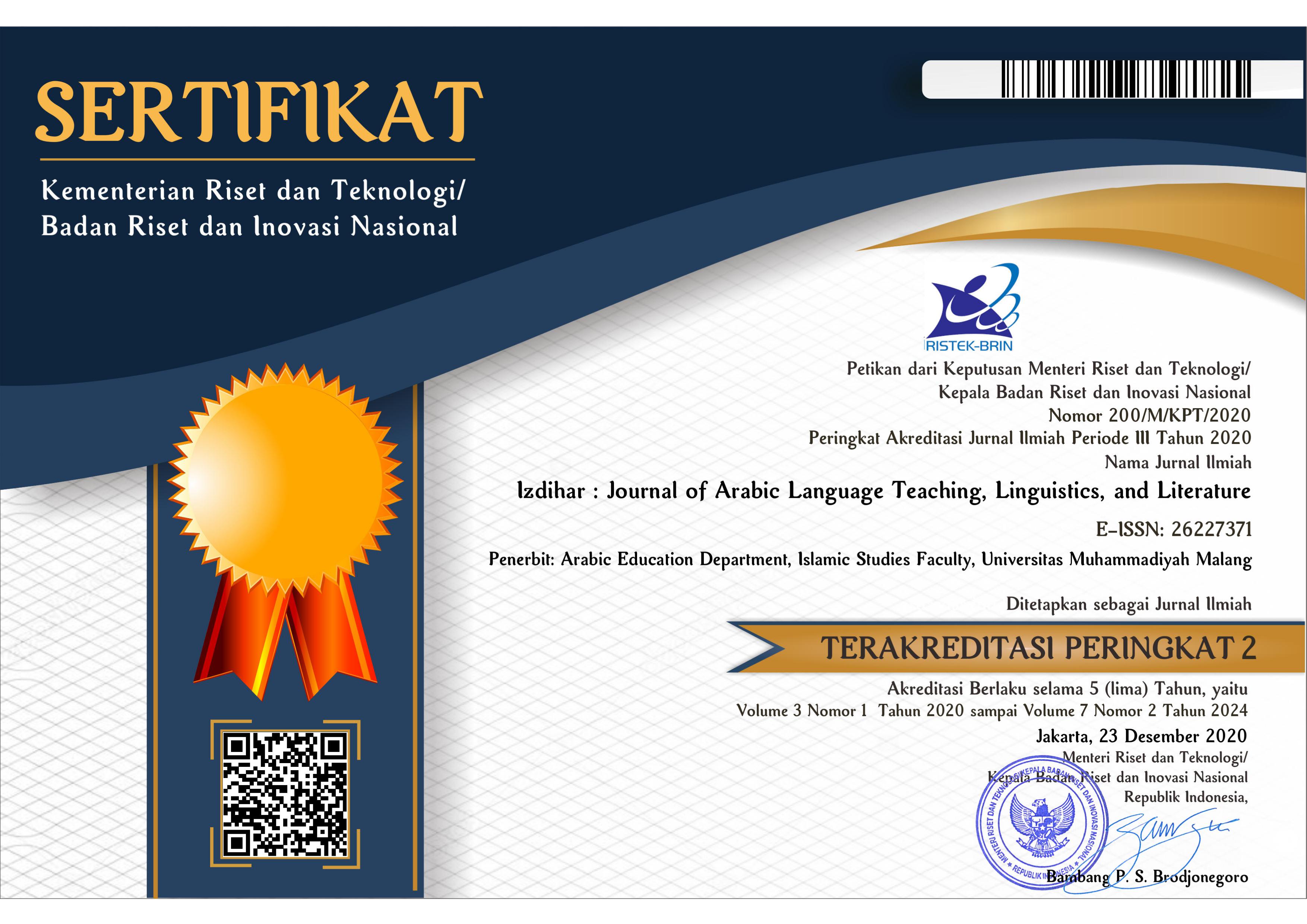Stylistic Analysis in Surah Al-Najm
DOI:
https://doi.org/10.22219/jiz.v3i2.11624Keywords:
Imagery, Semantic, StylisticAbstract
Stylistic is a multidisciplinary approach that aims to foreground the peculiar properties of texts on the basis of language and derive hidden and in-depth meaning to figure out major and minor themes. The evident fact that makes Stylistic a multidisciplinary approach is its retrievable, rigorous, and replicable principles. With Stylistic science, someone can reveal the secrets of the Qur’an as a whole by analyzing all aspects of the Qur’anic linguistics. This article aimed to analyze Surah al-Najm with the Stylistic theory. The research was qualitative research with library research or literature study. The analysis was carried out using an objective approach and descriptive analysis method by reading Surah al-Najm repeatedly then collecting relevant data. So, the data that has been found was analyzed with the two terms of Stylistics, they are semantics and imagery. From this study, it was concluded that in Surah al-Najm there were (1) nouns and verb preferences, various sentence structures and sentence confirmation in syntactic aspects, synonyms and antonyms in semantic aspects, and (2) several kinds of language styles such as isti'arah, majaz, and kinayah in imagery.
Downloads
References
Ahmad, F. S. (2014). Uslub al-Hakim wa Suratu al-Baqarah. Jurnal Lisanudhad. LISANUDHAD, 1(1), 19–33. DOI: http://dx.doi.org/10.21111/lisanudhad.v1i1.408
Ahsanuddin, M., Irhamni, I., & Asrori, I. (2019). The Representation of Cosmic in Hamzah Fansuri’s “Sidang Fakir Empunya Kata” Poem. In Proceeding of the First International Seminar on Language, Literature, Culture and Education. DOI: http://dx.doi.org/10.4108/eai.15-11-2019.2296219
Amalia, H. (2018). Gaya Bahasa Novel Azazil Karya Yusuf Zidan: Analisis Stilistika. Universitas UIN Sunan Kalijaga Yogyakarta. Retrieved from http://digilib.uin-suka.ac.id/32134/
Ash-Shabuni, A. M. (2003). At-Tibyan fi ulumil qur`an. Jakarta: Dar Al-Kutub Al-Islamiyah.
Ash-Shabuni, A. M. (2009). Shafwah At Tafasir Jilid III. Kairo: Makatabah Adab.
Ausi, ‘Abbas Ali. (2014). Asalibu Al-Mubalaghah Fi Al-Qur’an Al-Karim. Amarah: Misan University.
Fathoni, H. (2012). Gaya Bahasa Dalam Syair “Al-i’tiraf” Karya Abu Nuwas: Sebuah Analisis Stilistik. At-Ta’dib, 7(2). 205-224 DOI: http://dx.doi.org/10.21111/at-tadib.v7i2.72
Gao, C., & Zheng, Q. (2014). A Linguistic Study of Antonymy in English Texts. Journal of Language Teaching & Research, 5(1), 234–238. http://www.academypublication.com/issues/past/jltr/vol05/01/29.pdf
Hurford, J. R., Heasley, B., & Smith, M. B. (2007). Semantics: a coursebook. Cambridge: Cambridge university press.
Jaafar, E. A. (2014). A Stylistic Analysis of Two Selected Poems. Journal of College of Education for Women, 25(1), 238–248. https://www.researchgate.net/publication/311873842_A_Stylistic_Analysis_of_Two_Selected_Poems
Khan, M. I. (2016). Stylistic Dimensions in Translations of the Holy Quran into English with Special Reference of Sūrah Al-Fatiha. Journal of Education, Society and Behavioural Science, 12(4), 1–9. DOI: https://doi.org/10.9734/BJESBS/2016/20752
Khauli, M. A. (2000). ’Ilmu Dalalah: "Ilmu Ma’na. Oman: Darul Falah Linasyr wa Attauzi’.
Kostadinovska-Stojchevska, B. (2018). The Semantic Aspect of The Acquisition of Synonyms, Homonyms and Antonyms in the Teaching Process of English as a Foreign Language. European Journal of Foreign Language Teaching, 3(2), 28–43. DOI: http://dx.doi.org/10.46827/ejfl.v0i0.1555
Manzhur, J. M. I. al-anshari. (1969). Lisanu ’Arab. Beirut: Dar Sadir.
Murdiono, M. (2020). Non-Arabic Languages in the Qur’an according to as-Suyuti, Ibn al-Subki and al-Khafiz Ibn Hajar. LISANIA: Journal of Arabic Education and Literature, 4(1), 23–36. DOI: http://dx.doi.org/10.18326/lisania.v4i1.23-26
Muzakki, A., & Syuhadak. (2006). Bahasa dan Sastra dalam Al-Qur’an. Malang: UIN Malang Press.
Qalyubi, S. (2013). Stilistika Bahasa dan Sastra Arab. Yogyakarta: Karya Media.
Qutb, S. (1975). At Taswir Al Fani Fil Qur’an. Kairo: Dar Al Maarif.
Ratna, N. K. (2004). Penelitian Sastra: Teori, Metode, dan Teknik. Yogyakarta: Pustaka Pelajar.
Salim, A. G. (2015). Peran Kitab Suci Al Qur’an dalam Menjaga Eksistensi Bahasa Arab. OKARA: Jurnal Bahasa Dan Sastra, 9(1), 1–16. DOI: http://dx.doi.org/10.19105/ojbs.v9i1.577
Shihab, M. Q. (2002). Pesan, Kesan, dan Keserasian Al-Qur’an. In Tafsir Al-Misbah. Jakarta: Lentera Hati.
Subroto, E. (2007). Pengantar Metode Penelitian Linguistik Struktural. Surakarta: UPT Penerbitan dan Pencetakan UNS.
Suyuti, J. A. A. B. (1988). Mu’tarak al aqran fi i’jaz al Qur’an. Beirut: Dar al Kutub al Ilmiyah.
Umar, A. M. (2003). Al Isytirak Wa Iltidad Fi Qur’anil Karim. Kairo: Darul Falah Linasyr wa Attauzi’.
Yaqut, M. S. (n.d.). I’rab Alquran Al Karim. Kairo: Darul Maa’rif Al Jami’iyah.
Yeibo, E. (2011). Patterns of Lexical Choices and Stylistic Function in JP Clark-Bekederemo’s Poetry. International Journal of English Linguistics, 1(1), 137–149. DOI: https://doi.org/10.5539/ijel.v1n1p137
Zed, M. (2004). Metode Penelitian Kepustakaan. Yogyakarta: Yayasan Obor Indonesia.
Zuhaily, W. (2007). Tafsir al-Munir. Malaysia: Intel Multimedia and Publication.
Downloads
Published
How to Cite
Issue
Section
License
Copyright Notice
Authors who publish with this journal agree to the following terms:
- Authors retain copyright and grant the journal right of first publication with the work simultaneously licensed under a Creative Commons Attribution-ShareAlike 4.0 International License that allows others to share the work with an acknowledgment of the work's authorship and initial publication in this journal.
- Authors are able to enter into separate, additional contractual arrangements for the non-exclusive distribution of the journal's published version of the work (e.g., post it to an institutional repository or publish it in a book), with an acknowledgment of its initial publication in this journal.
- Authors are permitted and encouraged to post their work online (e.g., in institutional repositories or on their website) prior to and during the submission process, as it can lead to productive exchanges, as well as earlier and greater citation of published work (See The Effect of Open Access).
Copyright (c) 2019 Izdihar : Journal of Arabic Language Teaching, Linguistics, and Literature

This work is licensed under a Creative Commons Attribution-ShareAlike 4.0 International License.

















